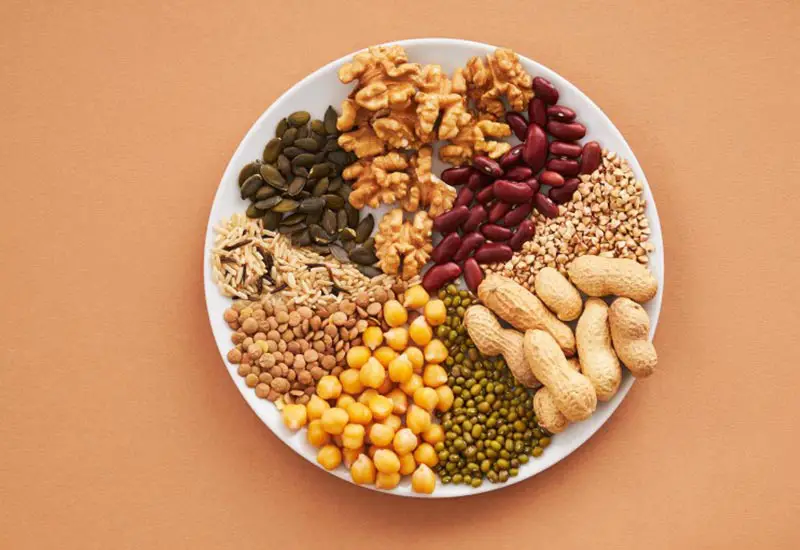Want to find out more about nutrition-related diseases? Then you've come to the right place! Our eating habits are often the cause of many serious complaints. Unfortunately, many people eat a very one-sided or unhealthy diet because they know too little about the importance and effects of their own diet.
The leading Causes of mortality in industrialized countries are cardiovascular diseases and cancer. An unhealthy lifestyle provides the breeding ground for these diseases to spread, so that ultimately the wrong diet, among other things, becomes a disease risk.
An appropriate one, wholesome diet can have both a preventive and therapeutic effect on diseases and thus make a major contribution to Improving the attitude to life and life expectancy.
In this article, we discuss 10 clinical pictures as a result of an incorrect diet, as well as their Causes, consequences and treatment options.
In advance you will find here a short Table of contents about the contribution:
- Overweight and obesity
- Diabetes
- Hypertension
- Atherosclerosis
- Cancer
- Osteoporosis
- Gout
- Diarrhea
- Constipation
- Metabolic syndrome
Notice: This article is not a substitute for medical advice, but merely provides general information about diet-related diseases. Please consult your doctor if you feel unwell or want to prevent health problems with medical care.
1. overweight and obesity
Two thirds of men and just over half of all women in Germany are overweight. Almost a quarter of adults are severely overweight, i.e. obese. This not only has serious health consequences for individuals, but also costs the healthcare system a whopping 29 billion euros.
Diet-related development of obesity
In most cases, obesity is caused by a combination of poor diet, lack of activity and exercise, as well as diseases of the thyroid gland. Eating habits are primarily shaped by infancy and childhood, the social environment and psychological factors. Poor nutrition then becomes a general disease risk, as obesity often leads to other diet-related diseases.
Diagnosis of overweight and obesity
For this, the Body Mass Index (BMI) is used. This corresponds to the formula "kg/m²". If the result is over 25, it is considered overweight. If the result is even higher than 30, this is a strong indication of obesity. However, one must criticize the fact that the BMI only considers body weight and not weight distribution, i.e. the ratio of body fat to muscle mass. This is because particularly muscular people weigh more than others, but are by no means overweight or obese. Therefore, another useful indicator of overweight is the Waist circumference, see table.
| Gender | increased | strongly increased |
| Male | > 94 | > 102 |
| female | > 80 | > 88 |
Consequences of obesity and poor diet
Diet-related illnesses such as overweight and obesity increase the risk of death. Risk of secondary diseases. These include type 2 diabetes mellitus, cardiovascular diseases, cancer, gout, blood clotting disorders, gallstones, non-alcoholic fatty liver disease, sleep apnea, diseases of the skeletal and musculoskeletal system, fertility disorders, skin diseases, reduced mobility and endurance, and psychosocial problems. Phew, that's quite a long list, but fortunately there are things you can do about it.
Dealing with overweight and obesity
The treatment of overweight and obesity lies in reversing the cause. If diseases are caused by an inappropriate lifestyle, they can be treated with an appropriate lifestyle. In concrete terms, this means changing the diet to a Wholesome, plant-based diet, with appropriate caloric intake, as well as the Reduction of processed food such as sugar or white flour.
The change in diet should be accompanied by a Increasing the activity level can be combined by the patient starting to move more. You don't even have to start with sport: Climbing stairs instead of taking the elevator, going for a walk or cycling to work instead of driving are also good first steps.
2. diabetes mellitus (type 2)

Another diet-related disease is type 2 diabetes mellitus, a condition formerly known as "old-age diabetes", in which patients suffer from an abnormally high blood sugar level.
Notice: Only type 2 is due to insulin resistance caused by an unbalanced diet. Diabetes mellitus Type 1 is not a diet-related disease, but is probably due to genetic and environmental factors.
Diet-related development of diabetes
The cause of abnormally high blood sugar levels is insulin resistance. This is caused by overeating and the increased storage of abdominal fat. Accordingly, the most important factors are Obesity, malnutrition and lack of exercise to the risk factors.
Diagnostic options for diabetes
There are various measurements that can be used to diagnose this nutrition-related disease. The Blood glucose values can be measured either in the morning as fasting blood glucose or during the course of the day as occasional blood glucose. The HBa1Cc value is considered a long-term parameter and shows the average blood glucose concentration over several weeks. Accordingly, this value is ideal for diagnosing diabetes.
Risks and secondary diseases of diabetes
Late damage that can occur with diabetes includes atherosclerosis, neurological disorders, diseases of the retina, as well as inflammation and vascular changes in the kidneys.
Prevention and therapy
As type 2 diabetes mellitus is a disease resulting from an unbalanced diet, a major contribution to preventing the disease lies in changing eating habits and - in general - lifestyle. As with obesity, this means increasing physical activity in combination with a wholesome diet with an appropriate calorie intake.
A vegan wholefood diet can be beneficial for type 2 diabetes due to the increased fiber content, the Reduction of saturated fatty acids, as well as the absence of the Risk factor meat not only have a preventive but also a therapeutic effect.
3. high blood pressure

Diseases of the Cardiovascular system are the most common cause of death worldwide at around 30 percent. In Germany alone, a total of 331,211 people died from cardiovascular diseases in 2019. Despite increasing life expectancy in Western countries, the risk of dying from cardiovascular disease is growing. The most common diet-related diseases of the cardiovascular system are high blood pressure and atherosclerosis.
Hypertensionalso known as hypertension, is a modern disease of civilization with which around 44 percent of Germans live. On average, men are slightly more susceptible to high blood pressure than women. Hypertension is a significant risk factor for other diet-related secondary diseases.
Wrong diet leads to high blood pressure
Nutritional risk factors The main causes of high blood pressure are obesity, a high intake of saturated fatty acids and the consumption of meat, fish and eggs. Other factors are stress, nicotine, alcohol and increased salt consumption, as well as increased age.
Hypertension diagnosis
Blood pressure is measured in mmHg, and a value of 140 over 90 or higher is officially considered hypertensive.
Notice: In recent years, the threshold values for blood pressure have been continually lowered. In 1980, the limit value was still 160 to 100, whereas nowadays we speak of first-degree hypertension at 140 to 90. This lowering of the threshold values means that far more people are considered "ill" and the sales figures for antihypertensive drugs generate high profits for the pharmaceutical industry. The exciting SWR documentary "In the land of lies" shows that this was similar for diabetes thresholds. Nevertheless, high blood pressure can be a serious disease risk.
Risks due to high blood pressure
High blood pressure leads to atherosclerotic changes and can promote kidney disease, atherosclerosis, heart attacks and strokes.
The right diet for high blood pressure
Here too, the key lies in the reversal from an unhealthy to a healthy lifestyle. healthy lifestyle. A plant-based diet With sufficient Fruit and vegetablesunsaturated fatty acids and a appropriate calorie intake form the basis for prevention and therapy. A high intake of fruit and vegetables in particular works wonders, as they contain the beneficial minerals Potassium, Magnesium and Calcium in high quantities. However, the intake of saturated fatty acids and trans fatty acids should be reduced.
In addition to natural treatment, drug therapy can also help by reducing the blood volume and thus reducing the tension in the blood vessels.
Tip: At Prevent heart disease you will receive further valuable health tips!
4. atherosclerosis
In the case of atherosclerosis, one speaks of a Calcification of the blood vesselsas they become clogged and lose elasticity due to the deposition of excess substances. The risk increases with age and, on average, men are affected more frequently than women.
Malnutrition and atherosclerosis
Atherosclerosis is primarily caused by an unhealthy diet, resulting in impaired glucose tolerance, poor blood lipid levels, overweight and obesity. Other diet-related factors are increased lipoprotein, diabetes mellitus and increased homocysteine levels. Risk factors that cannot be influenced are genetic predisposition, gender and increasing age.
Diagnosis of atherosclerosis
Blood lipid levels are the first indication of atherosclerosis. If the values are poor or you belong to the risk group, the blood vessels can be examined with an ultrasound, electrocardiogram or cardiac catheterization.
Potential consequences of atherosclerosis
The deposits in the blood vessels increase blood pressure on the one hand, and can lead to serious complications on the other. Blockages in the vessels come. Rather harmless consequences of this are Lack of blood circulation or Numbness. Blockages directly at the heart are problematic, as these can lead to the Heart attack lead to atherosclerosis. Atherosclerosis is therefore a particularly dangerous nutrition-associated disease.
Healthy diet for atherosclerosis therapy
Nutritional therapy for atherosclerosis is almost exactly the same as for hypertension. In addition, however, an increased intake of Omega-3 fatty acids recommended, as they are considered anti-atherosclerotic.
5. cancer
Cancer leads to increased cell growth or tissue formation, which in the worst case can lead to death.
Poor diet and cancer
The breeding ground for cancer often lies in lifestyle and an unbalanced diet. Obesity, animal proteins, too little fiber and lots of grilled, cured and smoked foods increase the risk of cancer. The exact Proportion of the diet in the development of cancer is difficult to study, but is likely to be around 30 to 35 percent and should therefore be weighted more heavily than nicotine or alcohol consumption.
Cancer prevention through a vegan diet

A vegan diet offers many benefits in terms of cancer prevention. It contains No animal proteins and is less likely to lead to obesity. Instead, fruit and vegetables, dietary fiber and various secondary plant substances, as well as Selenium the risk of developing cancer.
Tip: Especially many Dietary fiber are in Legumes, like Chickpeas, beans or lentils contain.
6. osteoporosis
Osteoporosis is often also Bone loss often develops gradually and results in an increased risk of bone fractures. In fact, the body is constantly building and breaking down bones. However, these processes are also dependent on certain nutrients and physical activity, among other things.
Development of osteoporosis due to wrong lifestyle
Risk factors that favor the development of osteoporosis are a lack of exercise, alcohol, caffeine and nicotine consumption, a too low Vitamin D-levels and, above all, the diet. Dietary factors include a high consumption of animal proteins, to little calcium, fruit and vegetables, as well as a high supply of Phosphate and Table salt.
Detection of osteoporosis
In order to diagnose osteoporosis, the bone density in critical areas is examined using low-level X-rays. This procedure is called the DXA method and determines the so-called T-value. Its reference values are shown in the following table.
| Normal value | > -1,00 |
| Osteopenia (precursor) | -1.01 to -2.49 |
| Osteoporosis | < -2,5 |
Nutrition-based osteoporosis therapy
Nutritional therapy for osteoporosis includes appropriate Calcium intake of at least 525 mg/day, sufficient fruit and vegetables and supplementation of Vitamin Das this is needed for calcium absorption. Soy products also appear to have a positive effect, which may be due to Soy isoflavones lies.
Ideally, nutritional therapy is supplemented with muscle-building training and balance exercises to strengthen the muscles and minimize the risk of falling.
7. gout
Gout is a Purine metabolic diseaseA disease in which the deposition of uric acid crystals on the joints causes painful swelling and inflammation. As purines are absorbed through food, gout is a diet-related disease.
Incorrect diet leads to gout
Uric acid is an end product of purine degradation - and if the kidneys do not manage to excrete enough uric acid, the crystallization process occurs. Therefore, purine-rich foods, such as meat, sausage, offal, fish and marine products are avoided. A low purine intake can lower the uric acid level so that the uric acid is excreted via the kidneys and the crystallization process does not occur.
However, it is interesting to note that plant sources of purine do not show a comparable increase in uric acid compared to animal sources.
Detection of gout
To diagnose gout, the uric acid level is measured. The reference range for men is 3.4 to 7.0 mg/100 ml and for women between 2.4 and 5.4 mg/100 ml.
The right diet for gout
A wholesome, plant-based diet can work wonders for gout. Because hardly any purines are consumed, the uric acid level drops and no further crystallization occurs. The body can gradually break down existing crystals and the symptoms disappear. It is also advisable to avoid alcohol and isolated fructose.

8. diarrhea
Diarrhea can have various causes. Secretory diarrhea is caused by a bacterial or viral infection. The body then tries to excrete the bacteria and viruses as quickly as possible, meaning that drug treatment to stop the diarrhea is critical. A safe alternative to this is the Moro carrot soup (also Moro soup The long cooking of the carrots results in the formation of so-called acid oligogalacturonides, which dock onto the germs in the intestine so that they are eliminated more quickly.
It is also particularly important that the body receives sufficient fluids to avoid dehydration. After a diarrheal illness, it makes sense to rebuild the body with prebiotics and probiotics. Prebiotics are effectively the "food" for the probiotic bacterial cultures.
"In the gut lies the origin of health or disease."
Chinese proverb
9. constipation
Constipation or constipation is considered to be a subjectively perceived inadequate defecation. According to the official definition, constipation is when one eliminates less than three times per week or less than 35 grams per day.
There are various causes of constipation, such as the Life circumstances and psychological factors. Accordingly, there is no general form of therapy; instead, it must be adapted to the exact cause. In general, it can be said that laxatives should only be used in the short term, as the bowel becomes sluggish and works less if taken over a longer period of time.
Simple means are Physical activity, stress reduction and a Adaptation of the diet. If you have diarrhea, you should eat fewer animal products and instead increase your intake of fiber, fluids, fruit and vegetables. Psyllium husks can be particularly helpful.
Tip: A diet rich in fruit and vegetables leads to diversity in the intestinal flora. Vegans have more Protective and anti-inflammatory bacteria in the intestine than in people on a mixed diet. Due to the increased fiber intake in the plant-based diet, more short-chain fatty acids are metabolized and the pH value in the stool becomes more acidic. This reduces the number of pathogenic putrefactive bacteria.
10. metabolic syndrome
The metabolic syndrome consists of four indicatorswhich together form a significant risk factor for fatal diseases of the cardiovascular system. This is why metabolic syndrome is often referred to as deadly quartet called. These include:
- abdominal obesity
- Hypertension
- Poor blood lipid levels or lipometabolic disorders
- Elevated blood sugar levels or insulin resistance
Metabolic syndrome can also be classified as a diet-related disease, as all four diseases are caused by a poor diet. The good thing is that the symptoms can be reversed with the right diet.
Diet-related diseases are preventable!
Sick from eating? That doesn't have to be the case. With a balanced, plant-based diet, you can do a lot for your health - both prevent and cure illnesses. Of course, this doesn't apply to every illness, but you can reverse many diet-related illnesses with a change of lifestyle.
Do you have any questions, tips or your own experiences with illnesses as a result of a poor diet? Then please write me a comment.
All the best,

P.S.: If you want to know more about a healthy lifestyle, I recommend the articles on Barefoot walking, Yoga, Cold showers and more energy in everyday life. Have fun!






